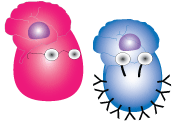
Antibody functions
Soluble antibodies have two functions: first they stick to and mark invading pathogens for destruction and second they take the invaders to the garbage dump. A single antibody can carry out both of these very different functions because the opposite ends of the molecule have very different structures. Antibodies can be broken into two large pieces using enzymes that separate the upper portion of the "Y" from the stem. The upper portion contains the two identical arms which are responsible for antigen binding and this fragment is called fragment antigen binding or F(ab')2. The stem is called fragment crystalizable or Fc because it forms crystals. The F(ab')2 end binds antigens whose shape is complimentary to their shape, and the Fc end binds to Fc receptors (FcR) that cover the surface of, for example, phagocytic cells. Notice in the following video how IgG antibody coats pathogens using their F(ab')2 regions while the Fc portions stick out like quills on a porcupine. Once docked onto FcR, phagocytic cells ingest and degrade the attached antigen as seen in this video.

It is not just phagocytic cells that respond to antibody tagged cells. NK cells also recognize IgG coated cells via their FcγRIII and this interaction makes the NK cell start killing the antibody coated cell. This is called antibody-dependent cell-mediated cytotoxicity (ADCC).
So IgG is involved in coating pathogens for pickup by phagocytic and cytotoxic cells. What function do the other isoptypes have?
IgA antibodies are produced in larger amounts than any other isotype because they function in the expansive mucosal immunity which protects both the gastrointestinal and respiratory tracts. IgA is produced locally in mucosal lymphoid tissues and secreted as dimers into the lumen where IgA binds to pathogens and prevents them from entering the host. Because IgA is produced and used locally, less than one quarter of antibody found in the plasma is IgA. The other isotypes are produced by plasma cells in the bone marrow and are found in the plasma. IgE defends against parasites but also is involved in mast cell degranulation during immediate hypersensitivity reactions. Find out more about that on the next page.